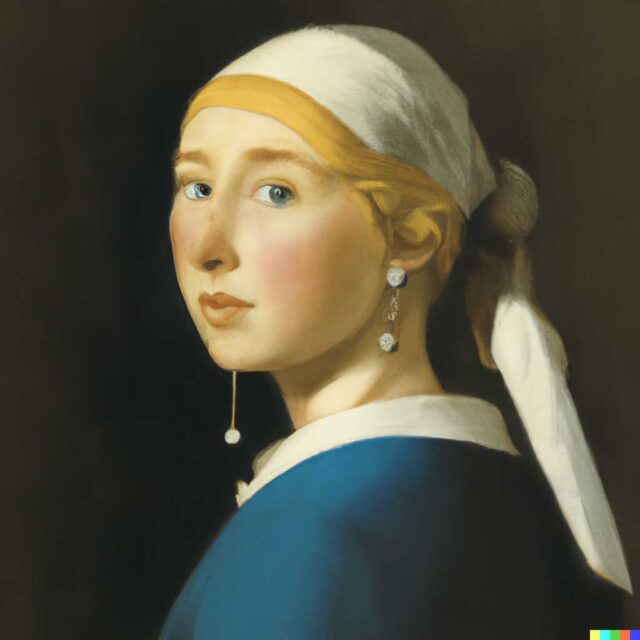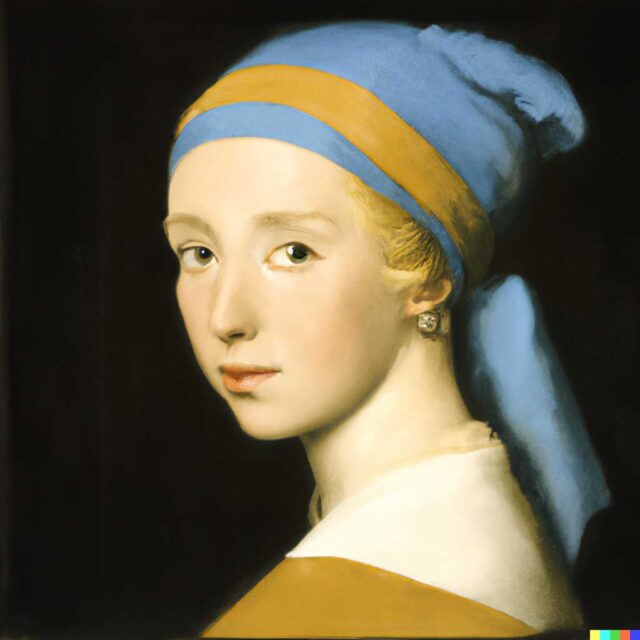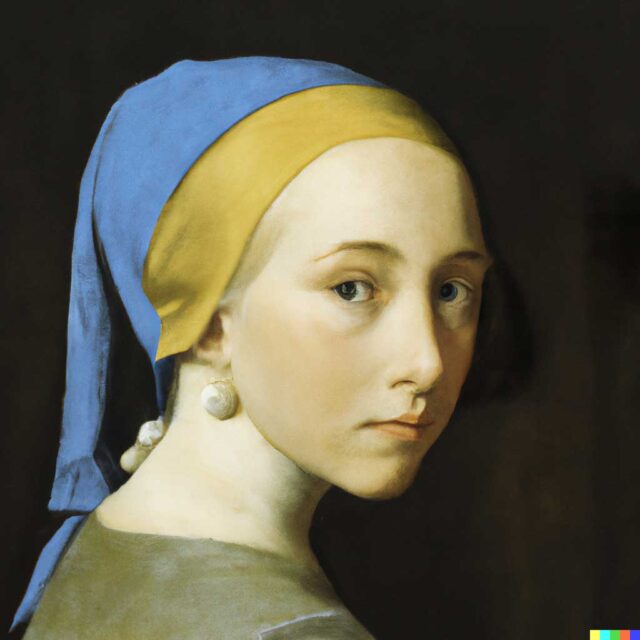From Public Books:
“The artist no longer creates work,” proclaims cybernetic artist Nicolas Schöffer, “he creates creation.” Schöffer’s remark is often quoted to describe art installations made with AI. It appeals because it flatters a classical hubris. Our species esteems itself as approaching the divine, godlike in our crafting of artifacts that then act like us. His remark also points to a consequence of expanding who, or what, is capable of artistic creation: Who gets to be an artist? How to become one?
It is indeed tempting to attribute creativity to machines. Take, for example, artist Sougwen Chung’s mechanical “arm,” D.O.U.G. (Drawing Operations Unit Generation_X). This machine was trained on Chung’s unique strokes; it roves over her canvas in live performances, drawing and painting in responsive collaboration with her. Or consider the 3D “robot artist” Ai-Da, who sees with camera eyes and sketches with a robotic arm. Her website specifies that she “is not alive, but she is a persona that we relate and respond to.”
However much it seems that D.O.U.G. and Ai-Da make art, each project has a human artist at the helm, with her own artistic vision and the impulse to carry it out. Yet whether imitating creativity or engaging in true creation, these art-making objects subvert our usual understandings of the artist as a type of author and of creativity as a uniquely human power.
Art’s relatively recent intersection with AI exposes the paradoxes of authorship, creativity, authenticity, and agency. In fact, the distinction between human and machine creation, as revealed in new books by Joanna Zylinska and Mark Amerika, is merely an artifice. The divide between the natural and the artificial functions as a device we produce and maintain. The artist too is cast as an invention: something that gets created over the course of producing an artwork, instead of asserted at its source.
. . . .
[This] called to mind Aristotle’s quip that art is the imitation of nature: the attempt by human skill to approach an ideal. His definition shaped the Greek concept of techne, referring not only to technology (Technik) but also to the “artistic” and “artificial” alike. In the art of computer science, are computer programs and algorithms then artistic objects that mimic nature? And if those objects are used to make more art—say, because they emulate the brain—should we regard them as mere tools, or as artists themselves?
AI art consists of art made with AI techniques, that is, specially trained computer models whose low-level structure mimics that of a brain. An artificial neural network like GPT-3 “learns” the patterns between words, such that it can predict the next word in a sequence or produce whole poems or news articles, for example, in the style of inputted sample text. OpenAI’s DALL∙E series was trained on text-image pairs and generates images based on text prompts. True to its etymology, the new DALL∙E 2 often outputs surrealist compositions. Users can input unusual combinations of things and abstract concepts (for example, “Bengal cat brothers sipping espresso and ruling the world”) and receive a range of visualizations in the time it takes to sharpen a pencil.
The existence of this genre poses a particular challenge. It calls into question whether art and artistic creation belong solely to humans. Zylinska and Amerika take up the challenge and champion the viability of a posthumanist art theory that views nonhuman entities as potential sources of art just as humans can be.
Link to the rest at Public Books
PG has been reading various articles and items discussing artificial intelligence. He won’t bore anyone with ethical, legal or copyright implications of increasingly more powerful ai technology and systems, but more visually-oriented ai creative projects are more interesting for a wider segment of the world.
The following is taken from the website of DALL·E 2, which describes itself as a new AI system that can create realistic images and art from a description in natural language. DALL·E 2 is a project of OpenAI, an AI research and deployment company.
Here’s an original painting that will be familiar to many, Girl with a Pearl Earring, an oil painting by Dutch Golden Age painter Johannes Vermeer, dated c. 1665:

Here’s a variant created by an artificial intelligence program developed by DALL·E 2

And another variant

and a third variant.

In answer to questions that may be entering the minds of those who are reading this post, PG says that ai writing tools are also in existence and will be getting much better within a short period of time.
This reminds me of the old joke:
Scientists announce that they have created artificial life. And God responds, “Make your own atoms.”
Meaning, that since they were using atoms that were already designed to form life, that they had “created” nothing.
The same with the art or the books.
Let’s see AI generate art from scratch, not seeded by human art. The same with books. It takes no effort to rearrange what humans have already done.
It’s like translating text, someone mentioned that the computer translations were based on countless human translations that are harvested by Google to mix and match real time translations.
– Remove the human samples they are using, and you have no translation.
Watch the documentary Tim’s Vermeer.
‘Tim’s Vermeer’ Trailer (2014): Tim Jenison, Penn Jillette
https://www.youtube.com/watch?v=94pCNUu6qFY
It shows how Vermeer actually painted his stuff. Basically he turned a human into a reprographics system. Tim does not know how to paint, but the mechanical system lets him copy what he sees, pixel by pixel. I watch the documentary on a regular basis to remind me of this.
Tim’s Vermeer – Full Documentary
https://www.youtube.com/watch?v=WPL7D0Ha1kQ
The other point is rather disturbing to me, but makes for great Story.
I have mentioned many times that Story comes from the Imaginal Realm, or King’s “Boys in the basement” or Fantasia or the books sitting on the shelves in Dream’s Library. This is not a metaphor, it is literal. Stories are not “made up” they are harvested by human translators. It requires a human mind to translate Story from the Imaginal Realm to the page.
If they built a machine that could be that translator — be afraid, be very afraid — because the entities in that Imaginal Realm would have unfettered access to our Reality.
Stephen King wrote Pet Cemetery, and Lisey’s Story, where entities try to enter our reality but are too large to fit in one mind.
Shadow Unit is an online series, essentially an unproduced TV series, that says the same thing.
Shadow Unit
http://www.shadowunit.org
“The universe we see playing out in space and time may be just the surface level, where we float like little boats while leviathans stir in the deep.”
— George Musser
Speaking of the Lord of Dream’s library, it’s seen better days.
But it’ll get better in two months:
https://www.youtube.com/watch?v=cWJTB6FPVaA
Aug 5 is the day Netflix servers crash. 😀
Now you’re talkin’.
Speaking of: STARDUST?
Book or movie? I need to do both again.
Thanks…
Either.
A three medium success.
But in this conrext, movie.
So many things done right that critics never understood.
Time has been kinder.
They certainly haven’t figured out ears yet.
If these were generated by “a description in natural language” then it’s very clear that Vermeer’s original was part of the training data set used to develop the AI and that the instructions given to DALL-E 2 ensured that it homed in on “variations on a theme by Vermeer” (with odd other influences such as on the lipstick in image 1 – Clara Bow? -and the eyebrows in all the images).
The only real problem is that the artistic quality of the images is much lower that the original (compare the head covering for example). They made me think of a careful and technically competent beginner with no spark. The original is ten times better and if someone wants to say “You too can own a one of a kind Vermeer”, I’m going to be saying “I want me money back”.
The depressing thing is that they’ll keep adding extra hidden layers to their neural nets – maybe with a bit of recurrence or whatever thrown in – and upping the size of the training data set until they get so close to producing a “real” Vermeer, Rembrandt or Canaletto that we won’t notice that the spark of human creativity is lacking. And if that’s the case we may have to admit that it needn’t be missed, since it certainly is not in the electronics or the software…
Do tbey sell “starving artist originals” in the UK?
These Faux-AI pics are done for two reasons, maybe three:
1- Academics proving it can be done. Whoop dee doo. So?
2- To sell wall decor. The market for the “starving artists”. Okay, that’s the answer to “so?”
https://humorcolumnistblog.com/2019/08/06/the-starving-artist-art-sale-07/
3- To scam the unwary. Mostly those that think “fine art” is a good investment or buy for bragging rights.
The whole point of serious art paintings (today) is the human element.
Without it it might as well be stock art.
That said, computer generated starving artist art might be useful for generating book covers:
Pick a style: Freas, Whelan, Morrow, Bros Hildebrant or Frazetta. Anime, tough guy action, or bodice ripper.
Then you describe the scene, describe the genre, characters, scenery, etc. Iterate at will. Pay $50 when satisfied.
A single web site could serve all of tradpub.
The second gen software would read the manuscript and make sure the cover is representative of the story.
The third generation would do better: editing and proofing, provide the payday loan advance, and schedule the pbook printing and distribution. One stop tradpub. No agent or BPH needed. Just authors and readers. 😀
Faux-AI art is looking to be the modern equivalent of the “dogs playing poker” pictures.
Beats their paintbrush splatter and “starving artists” precursors, I suppose. Those artists will actually be starving now.
I can imagine the late night informercials: “You too can own a one of a kind Renbrant! No two the same, or your money back!” Only $ 39.99 with free shipping.
(Gotta factor in inflation.)